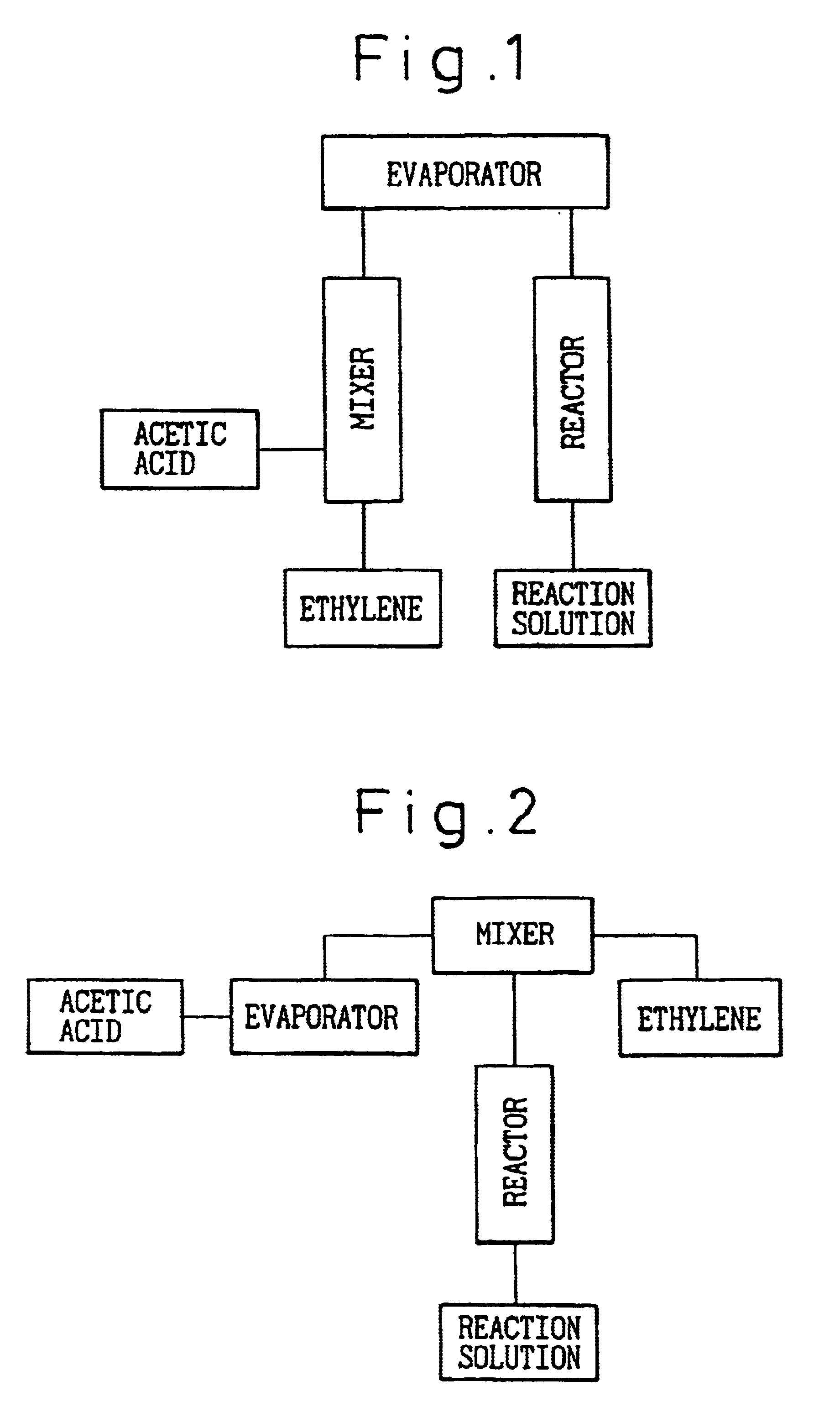Process for producing mixed gas of lower olefin and lower aliphatic carboxylic acid, and process for producing lower aliphatic ester using the mixed gas
a technology of aliphatic carboxylic acid and mixed gas, which is applied in the preparation of carboxylic acid esters, chemistry apparatus and processes, and organic chemistry. it can solve the problems of large amount of energy required to gasify completely, large heat of vaporization, and deactivation of catalysts, etc., and achieves high boiling point, high efficiency, and easy gasification
- Summary
- Abstract
- Description
- Claims
- Application Information
AI Technical Summary
Benefits of technology
Problems solved by technology
Method used
Image
Examples
example 2
The catalyst used was the same as that used in Example 1.
Using the reactor shown in FIG. 1, ethylene, acetic acid and water were fed in a molar ratio of 87.0:5.0:8.0 from the respective inlets at a space velocity of 1,500 hr.sup.-1 under a pressure of 0.9 MPa. Water was fed together with acetic acid. In this case, the temperature at which the acetic acid-water mixture vaporized was 102.3.degree. C. When the reaction system was heated so that the catalyst layer had a peak temperature of 165.degree. C., the reaction results were such that the STY of ethyl acetate was 176 g / l-cat.multidot.h and the selectivities of ethyl acetate, ethanol and diethyl ether were 91.5%, 4.3% and 3.7%, respectively.
example 3
The catalyst used was the same as used in Example 1.
Using the reactor shown in FIG. 1, propylene, nitrogen, acetic acid and water were fed in a molar ratio of 80.0:10.3:6.7:3.0 from the respective inlets at a space velocity of 1,500 hr.sup.-1 under a pressure of 0.9 MPa. Nitrogen was fed together with propylene and water was fed together with acetic acid. In this case, the temperature at which the acetic acid-water mixture vaporized was 105.6.degree. C. When the reaction system was heated so that the catalyst layer had a peak temperature of 165.degree. C., the reaction results were such that the STY of isopropyl acetate was 243 g / l-cat.multidot.h and the selectivities of isopropyl acetate, isopropanol and diisopropyl ether were 94.7%, 2.8%, and 2.3%, respectively.
example 4
The catalyst used was the same as used in Example 1.
Using the reactor shown in FIG. 1, ethylene, nitrogen, acrylic acid and water were fed in a molar ratio of 80.0:10.3:6.7:3.0 from the respective inlets at a space velocity of 1,500 hr.sup.-1 under a pressure of 0.3 MPa. Nitrogen was fed together with ethylene and water was fed together with acrylic acid. In this case, the temperature at which the acrylic acid-water mixture vaporized was 85.6.degree. C. when the reaction system was heated so that the catalyst layer had a peak temperature of 165.degree. C., the reaction results were such that the STY of ethyl acrylate was 52 g / l-cat.multidot.h and the selectivities of ethyl acrylate, ethanol and diethyl ether were 91.8%, 4.3% and 3.5%, respectively.
PUM
| Property | Measurement | Unit |
|---|---|---|
| pressure | aaaaa | aaaaa |
| temperature | aaaaa | aaaaa |
| vaporization temperature | aaaaa | aaaaa |
Abstract
Description
Claims
Application Information
 Login to View More
Login to View More - R&D
- Intellectual Property
- Life Sciences
- Materials
- Tech Scout
- Unparalleled Data Quality
- Higher Quality Content
- 60% Fewer Hallucinations
Browse by: Latest US Patents, China's latest patents, Technical Efficacy Thesaurus, Application Domain, Technology Topic, Popular Technical Reports.
© 2025 PatSnap. All rights reserved.Legal|Privacy policy|Modern Slavery Act Transparency Statement|Sitemap|About US| Contact US: help@patsnap.com

